Who doesn't love strawberry jam?
When strawberries are fresh and in season there's nothing like them. That ripe, fragrant, delicious fruit that tickles your nose and makes your tastebuds sing. Strawberry season is also the perfect time of year to consider making your own strawberry jam. To illustrate why I've done a quick rundown on several brands of strawberry jam available at my local grocery store.
Just a few notes
About strawberries
Strawberries are one of the Dirty Dozen. Put together by the Environmental Working Group every year, this list shows the 12 fruits and vegetables most likely to be contaminated by pesticides. In the case of strawberries, it's overwhelming.
Just last year the USDA examined pesticide levels in food. Strawberries were found to contain a wide variety of fumigants that were linked to developmental problems in children, cancer, hormonal disruption, neurotoxicity, and even some which were toxic to honeybees.
All of this adds up to make it vitally important that we choose organic strawberries. And strawberry products. Like jam.
What's in the jar?
As with any jar, the lid most likely contains BPA. Heat, pressure, and food contact are some of the ways that BPA can be transferred to the food. It's nearly impossible to avoid.
When looking at labels I deliberately did not choose those jars which contained artificial sweeteners. I believe these to be so toxic to the body that no one should eat them. Ever. So it did not make sense to include them in this post. I do want to point out, however, that there were just as many jars that contained artificial sweeteners as there were jars without.
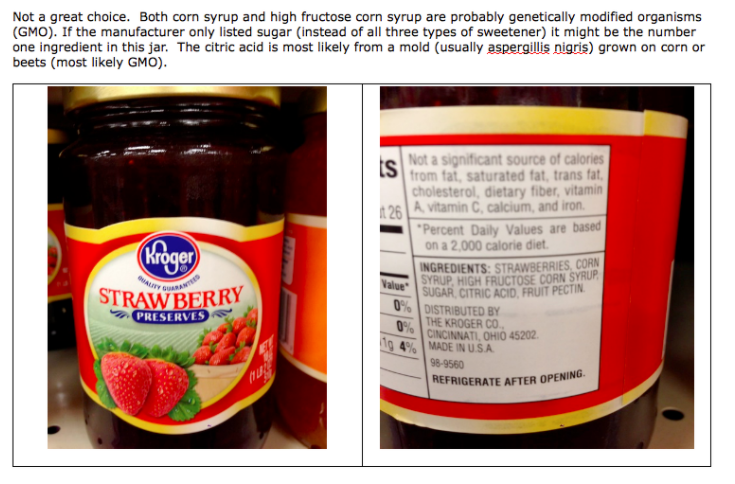
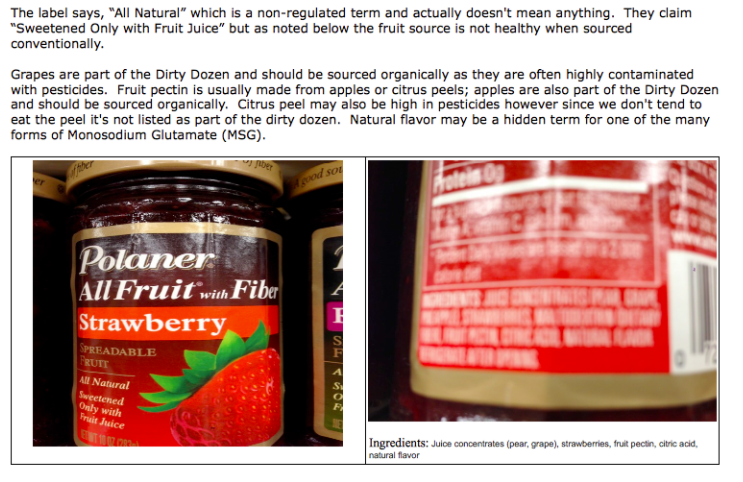
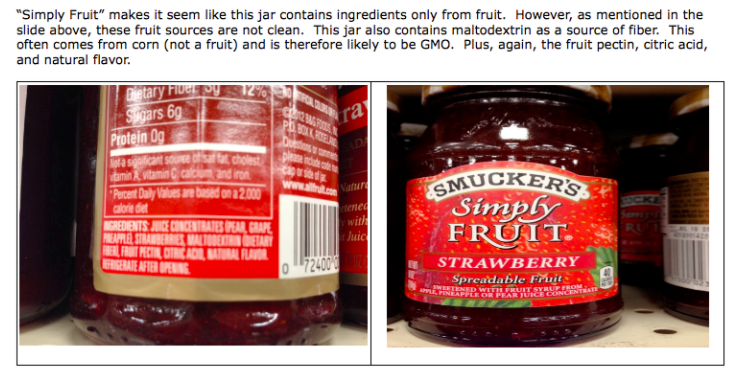
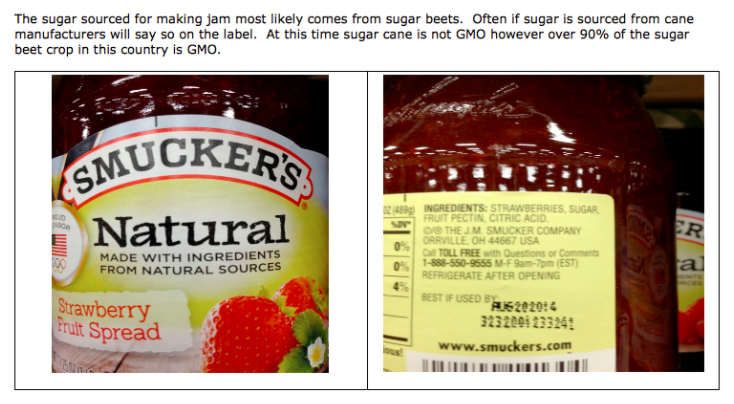
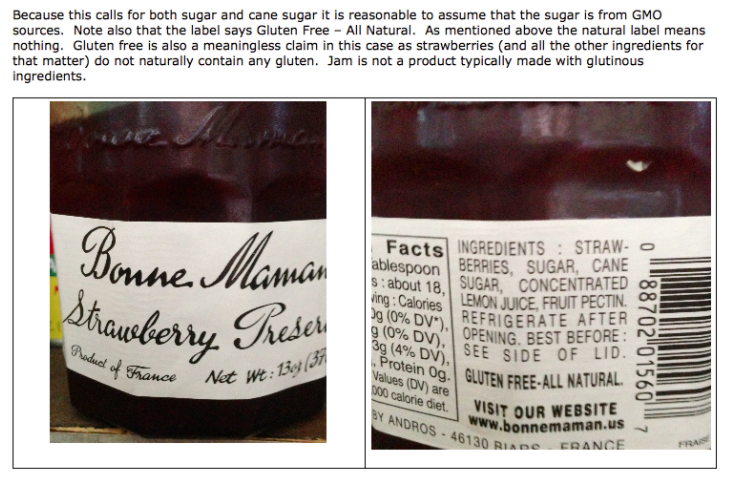
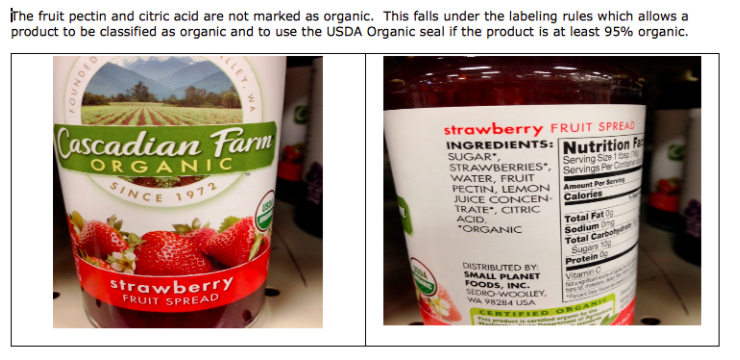
Making strawberry jam
Strawberry jam is super easy to make on your own. Canning itself is a simple, albeit hot and humid, process. When I teach canning classes I usually teach how to make strawberry jam because it's so easy. After learning how to make it, invariably, the students say, “Is that it? That's so easy.” Yes it is. If you have a good source of organic fresh strawberries near you, consider making your own jam.
This very simple recipe comes from The Ball Blue Book. My copy is rather old, tattered, and stained. But the recipes are still delicious. This is a great book to start with if you're just learning about making jams, jellies, pickles, and chutneys. There's a host of good recipes in this book.
It is important when using this recipe to measure the amount of strawberries first and then crush. If you do it the other way you will make a delicious strawberry sauce but it won't set. If you have the opportunity to pick your own strawberries try to get some that still have the white tips on them. I find that these help to make it set better.
It's also important to use evaporated cane juice crystals and not sucanat. I'm assuming that it's because of the higher mineral content, but I have not had success using sucanat in canning.
Simple Strawberry Jam
Ingredients
- 2 quarts strawberries, washed, hulled, and crushed
- 6 cups evaporated cane juice crystals
Instructions
- Combine berries and sugar in a large sauce pot.
- Bring slowly to a boil stirring until sugar dissolves.
- Cook rapidly until thick, about 40 minutes.
- As mixture thickens, stir frequently to prevent sticking.
- Pour hot into hot jars, leaving 1/4 inch head space.
- Adjust caps.
- Process 15 minutes in a boiling water bath.

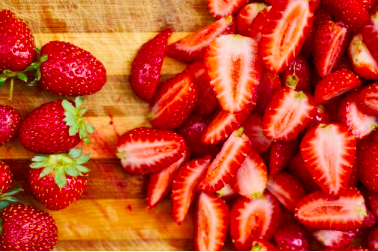

Oh goodness, another food I have to be afraid of? Yikes! Good thing I don’t eat jams and jellies due to the amount of sugar in most of them … I maybe buy one or two jars a year made locally from local farmers at local farmers markets. I’m okay with those right?
I am never surprised by a label anymore. The more we prepare our own food the better off we’ll be. I agree with, Trudy on the sugar. I don’t add any sugar or sweeteners to my food but I understand not everyone wants to go cold turkey like me. At least with the homemade version they might be able to lower the sugar content a bit.
Thank you for the great information
on the labeling and descriptions.
I eat strawberries every single day
and use them in home made smoothies.
No longer eat sugar so the jam is out
for me.
Thanks for sharing the recipe for Jam – makes you realise just how much sugar is in things today – a tiny scrape will probably still overload the sugar cravings brain cells
Thanks Sue. Someone’s got to do it 🙂 Luckily for me I actually love looking at all of the labels. You should see how excited I get when my friends bring me packages for things I’ve never seen before such as peanut butter with anchovy oil in it (so they could say DHA fortified on the label).
Hi Trudy, I know, most people are really surprised to find out how much sugar there actually is in jams and jellies.
Hi Jessica. “processing” means to put the sealed jar in a pot where it is completely covered by water. Bring to a boil and then boil for however many minutes (in this case 15)
You do need to buy a jar that is a canning jar so it will hold up to the heat and pressure of canning. Usually two part lids are the easiest to find, they have a ring and a sealable lid. The jar and the ring are re-usable, however unless you’re using Tattler lids the lids are not.
What does “Process 15 minutes in a boiling water bath” mean? It does sound really simple and so much healthier than what I buy in the store. Did you say the type of jar I buy matters?
Great analysis of the commercial jams – horrible!
I hate to be a party-pooper but even home-made jam would be an issue for me and my clients – way too much sugar (even if it’s organic)
I love this “And there’s nothing like a ripe, fragrant, delicious strawberry to make your tastebuds sing” This is how I enjoy my strawbs – fresh or frozen
As always, I’m kind of glad and kind of sad to read your article. 🙂 I so appreciate your detailed research.
Mira, great information to know! Thank you. This reminds me of a day I spent with friends a few years ago making delicious strawberry jam!